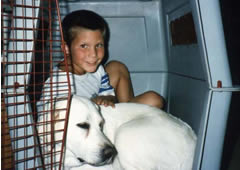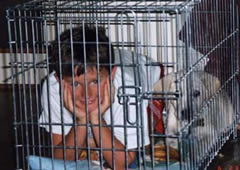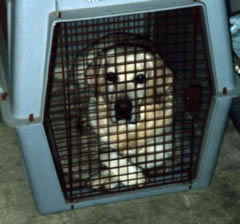 |
Sign Up For Our Newsletter!
 |
||||||
Your New Puppy: Crate TrainingSee Also: Feeding Your New Puppy
Under most circumstances, I am very cautious about using the words always or never. Maybe it's my years of veterinary experience telling me that anything can, and often will, happen. But, when it comes to "man's best friend", perhaps the canine's best friend is their crate. The Labradors Of Bainbridge will always be crate trained, and anyone who takes one of our pups into their home will always be thoroughly introduced to the how's and why's of using a crate for their new puppy. It is simply the best you can do for your new companion. You may hear or read different discussions on the proper utilization of a dog crate, but here is a bit of a look into our philosophy and the methods we use. From the very first day your new pup arrives, you should have a crate available. While some may suggest beginning a young Labrador puppy in a smaller crate and upsizing at a later time, we start our pups out in adult Labrador size crates. The dimensions should be in the range of 40" x 30" x 27", which is the exact size of the crate seen in the photos on this page. They made be made of the sturdy, lightweight synthetic material seen here, or you may choose to have a "wire" crate for your pet. We utilize both, but the difference is important to consider. The lighter, plastic ones will easily disassemble at their midline. They are easy to move from room to room and can be readily moved to a vehicle for those who like to transport their pets in a sport utility vehicle, for example. The wire crate, for our purposes, is more of a stationary object. It too will collapse and fold up for transport, but it is heavier and involves a much more cumbersome process to assemble and break down. We keep a number of the wire crates in our basement kennel area. They are rather "permanent" in that the dogs might utilize them on a daily basis but we don't move them around. Our dogs are so fond of their crates that they even know which one is their own. When we are ready to "put them up", they'll actually stand in front of the door to their crate and wait for us to let them in. So now that you have your new puppy and his (or her) new crate, what's next you might ask? You must first realize that you're not being a cruel person for insisting that your new friend be crate trained. This is essential and you must not waiver. Follow the advice of those who have been through the process, give it a chance, and I am 100% sure that you will later agree it is one of the best services you can provide for your new pup. In fact, when your friend or neighbor decides to add a Lab puppy to their family, you just might find yourself being the first to advise them on the merits of crate training their dog! The Dark Of NightThose first few days (actually nights!) will be the toughest. After that, it's all downhill. The way we approach it, you'll have several options to choose from. We'll discuss more about feeding under that individual topic, but for our purposes here, a new puppy should not be fed within several hours of "bedtime". We never advise leaving food or water in the crate with the pup. They can have plenty of toys, other things to chew on, or a dog biscuit or two. In fact, we generally give our dogs a biscuit every time we put them in their crate. (Now you know why they stand at the door waiting to jump in!). Alright, so everything is prepared. Got the toys, got the crate, got the biscuits. Now get the dog! Although we are firm about the use of a crate, we realize that everyone will find a format that best suits the needs of their individual household. Please understand that your pup has been handled and given an awful lot of attention and affection while being raised. That's one aspect that may separate The Labradors Of Bainbridge from others. The biggest obstacle you will encounter will not be due to confinement in the crate, but rather from the pup's fear of being left alone with no one around. Remember, she has always had her siblings to cuddle up with or the warm lap of a human to curl up on. This is her first experience away from the familiar environment where she was raised, so keep that in mind the first few days. As mentioned above, at bedtime you have several options depending on your individual situation. Remember that an eight-week-old puppy will most likely not make it through the entire night without a trip to the back yard. You may choose to put the crate in your bedroom, next to your bed, or at least in close sight so that the pup will be able to see you. Sometimes, if they begin to cry, just the simple act of sticking your fingers through the crate will provide enough reassurance to soothe and settle her down to sleep. In addition, the closer to the crate that you are, the easier to awaken when she begins to stir for a trip outside. Sometimes, when a husband or wife or significant other doesn't want to be awakened during the night, another method may work to solve the problem. Try moving the crate and the puppy to another room of the house, perhaps the family room, where you can lie on a couch or sofa and keep the pup right in front of you. This allows one member of the family to take care of the young pup's needs while the other sleeps through the night. It works very well, that is of course, after the decision is made as to who sleeps where! And then there's the method that we use, weak as we are, which is to let the pup slip up onto the bed with you and sleep right next to you. How do you spell instant success? That's it right there. This helps to get through the first few nights very easily. At the same time you have the days to help get the pup accustomed to the crate. A little wimpering during daylight hours pales in comparison to that heard in the dark of night. The Light Of DayAlright. I understand using the crate at night. But why do I have to "lock him up in there" during the day. How about if I block him off in the laundry room? or on the porch? There's nothing he can hurt there any way. I'll be gone only a couple of hours and he can play outdoors when I get back. First of all, you're not "locking him up in there". In a few days you'll most likely find him wandering into the crate on his own accord when you're home if you leave the door open for him. But better yet, how about if you decide which scenario has better appeal: (A) You decide Elliott (let's give our typical pup a name, OK? and we have an Elliott who just may have gone through a similar stage, so let's borrow his name) is better in the laundry room than in his crate while you go out for a few errands. After all, it'll just be for two hours or so. You barricade the doorway so he can't get out. Oh yeah, let's not forget the chew-toys. They said he always should have plenty of toys. And maybe a bit of water in case he gets thirsty while I'm gone. (Such a thoughtful master!). Elliott being taken care of, you leave after peeking in, observing him totally absorbed in that new rope-chew you just bought him. While starting the car, you mumble to yourself something that might sound like.......'I don't know why those people think he has to be in that crate every time I'm gone. Poor little guy. It'll just be for two hours'. You return and all is quiet as you enter. You approach the laundry room to let that cute little Elliott out to play and then, all of a sudden, as if possessed, you yell out, (and I only paraphrase here), "Ellllll-eeeee-uuttttt! Look what you've done! You've got all those toys and you've chewed a hole in the wall! Right through the #%/*&\ wall! And you've knocked over your water bowl as well! Go on. Get out of this house. Now! And you may not ever come in here again!" While this rampage is occurring, the once cute little puppy Elliott, is now seen cowering in the corner with his head down, totally frightened, having no clue what he has done. After all, everybody knows puppies need to chew. They get bored easily, too. And he was tired of that rope toy after a few minutes anyway. And the wall.....well heck, he chewed on the wall nearly an hour ago. That was before he took a little nap before you came home. MORAL OF THE STORY: You're mad, he's frightened, and he has no clue what he's done, even though you were overheard several times yelling something about the #%/*&\ wall. This lose-lose situation could have been avoided by...... (B) You decide Elliott has got to learn to get used to his crate and the short trip to run a couple of errands provides a good training session. "Come on, Elliott. Kennel. Good boy. Your toys are in there and here's a biscuit for you too. You can have some water when I get back." With the shopping done, you pull into your driveway, enter your home and hear some curious thumping noise coming from the family room where Elliott's crate is. "What can that be?" You hurry to the den only to find a happy little puppy who couldn't help from thumping his tail back and forth against the side of his crate as he playfully greets you, knowing his master is back and it's time to go out and play together! What a win-win situation that is! Moral of the Story:
|
||||||
The Story of Bainbridge | About Us | What Others Are Saying | Memorials | The Home Team | Photography | Your New Puppy | Veterinary Topics | Dr.'s Newsletter | Contact Us | Online Store | Links | Home Page
White Labs by Dr. Joseph Demichael, DVM - The
Labradors of Bainbridge
Ph: (859) 299-6200 | Email: whitelabs@bainbridgelabs.com | Site
Map
© Dr. D’s for Dogs (USA) 2010, Lexington, Kentucky
All worldwide rights reserved. Dr. D’s for Dogs is a trademark
of Dr. J. Demichael, DVM




